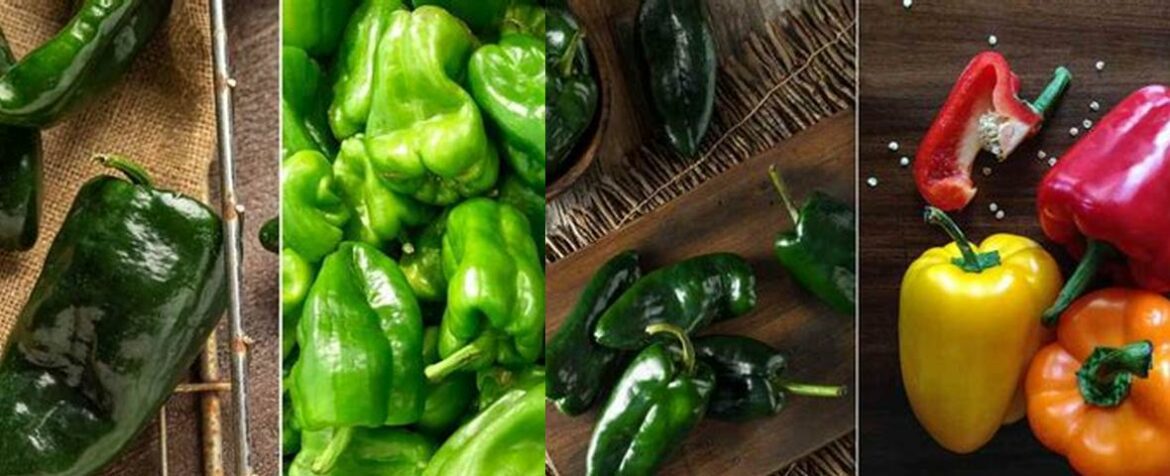Poblano vs bell pepper: Are you ready to spice up your culinary adventures? In the world of peppers, the battle between Poblano and Bell Pepper is heating up. These two flavorful contenders bring their own unique flavors and versatile culinary applications to the table. Whether you’re a seasoned chef or a home cook looking to add some pizzazz to your dishes, this Poblano vs. Bell Pepper showdown will have you reaching for your apron and diving into the kitchen. Get ready to explore the differences, similarities, and mouthwatering potential of these two pepper powerhouses. Let’s dig in!
Poblano vs. Bell Pepper: Exploring Unique Flavors and Versatile Culinary Applications
The world of peppers is vast and diverse, offering a myriad of flavors, colors, and textures to culinary creations. Among the most popular and commonly used peppers are poblano and bell peppers, each with its unique characteristics and culinary applications. This blog post delves into the fascinating world of poblano and bell peppers, exploring their differences in flavor, appearance, versatility, and nutritional value, providing insights into their culinary uses and tips for selecting, storing, and cooking with these versatile ingredients.
Flavor and Appearance: A Tale of Two Peppers
Poblano peppers, renowned for their rich and smoky flavor, possess a mild to medium heat level, ranging between 1,000 and 2,000 Scoville units. Their distinct flavor profile, combining earthy, smoky, and slightly sweet tones, makes them a staple in Mexican cuisine, where they are used in dishes like chiles rellenos, mole sauce, and salsa.
In contrast, bell peppers, known for their vibrant colors and mild, sweet taste, are culinary chameleons, adapting seamlessly to various cuisines and dishes. Their flavor is often described as tangy and slightly sweet, with a crisp and juicy texture. The absence of heat makes them suitable for individuals with a low tolerance for spicy foods.
Versatility in the Kitchen: A Culinary Journey
Poblano peppers’ larger size, softer texture, and thicker skin make them ideal for stuffing, roasting, and adding to soups or stews. Their smoky flavor adds depth and complexity to dishes, while their mild heat provides a subtle kick.
Bell peppers, with their diverse colors and firm texture, are incredibly versatile. Their mild flavor and crunchy texture make them a welcome addition to salads, stir-fries, fajitas, and stews. Their vibrant colors add visual appeal to any dish, making them a favorite among home cooks and professional chefs alike.
Nutritional Powerhouses: Unveiling the Health Benefits
Both poblano and bell peppers are nutritional powerhouses, packed with essential vitamins, minerals, and antioxidants. They are excellent sources of vitamins A and C, essential for maintaining a healthy immune system and promoting overall well-being.
Poblano peppers, with their capsaicin content, have been associated with boosting metabolism, reducing inflammation, and potentially aiding in pain relief. Bell peppers, rich in carotenoids, are known to enhance immune function, protect against oxidative stress, and promote eye health.
Selecting and Storing: Ensuring Freshness and Quality
When selecting poblano and bell peppers, look for firm, brightly colored peppers with smooth skin. Avoid peppers with blemishes, bruises, or wrinkles, as these indicate poor quality or age.
To store poblano and bell peppers properly, wash and dry them thoroughly. Place them in a plastic bag in the vegetable drawer of the refrigerator for short-term storage, typically up to a week. For long-term storage, wrap them individually in paper towels or place them in a clean container with a lid and store them in the freezer for up to 6 months.
Culinary Inspiration: Unleashing the Potential
The culinary possibilities with poblano and bell peppers are endless. Poblano peppers’ smoky flavor shines in dishes like chiles rellenos, where they are stuffed with cheese, meat, or vegetables and coated in a flavorful sauce. They also add depth and complexity to moles, stews, and soups.
Bell peppers, with their vibrant colors and mild flavor, are a versatile addition to stir-fries, salads, fajitas, and casseroles. Their crunchy texture and tangy sweetness complement various ingredients, making them a popular choice in many cuisines worldwide.
Conclusion: A Culinary Symphony of Flavors and Versatility
Poblano and bell peppers, each with their unique flavor profiles, textures, and culinary applications, offer a symphony of flavors and versatility in the kitchen. Whether exploring the rich, smoky notes of poblano peppers in Mexican cuisine or embracing the vibrant colors and mild sweetness of bell peppers in international dishes, these two peppers are sure to elevate any culinary creation. Experimenting with different cooking techniques and flavor combinations unlocks a world of possibilities, allowing home cooks and professional chefs alike to create memorable and delicious dishes that tantalize the taste buds and leave a lasting impression.
FAQ about Poblano Vs Bell Pepper
Q: What is the difference between poblano and bell peppers?
A: Poblano peppers have a rich, smoky flavor profile, while bell peppers have a mild sweetness.
Q: What are the culinary applications of poblano peppers?
A: Poblano peppers are commonly used in Mexican cuisine, particularly in dishes like chiles rellenos, moles, stews, and soups.
Q: How can I use bell peppers in my cooking?
A: Bell peppers are versatile and can be used in various international dishes. They add vibrant colors and mild sweetness to salads, stir-fries, fajitas, and sandwiches.
Q: What should I look for when selecting poblano and bell peppers?
A: When selecting peppers, look for firm, brightly colored peppers with smooth skin. Avoid peppers with blemishes, bruises, or wrinkles, as these indicate poor quality or age.
Q: Can I substitute poblano peppers with bell peppers in recipes?
A: Yes, you can substitute poblano peppers with bell peppers if you prefer a milder flavor. However, keep in mind that the smoky notes of poblano peppers will be missing.
Q: Are there any specific cooking techniques that work well with poblano and bell peppers?
A: Poblano peppers are often roasted and peeled before being used in recipes, while bell peppers can be grilled, sautéed, or used raw depending on the desired texture and flavor.


